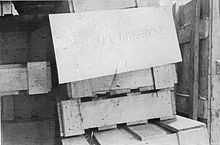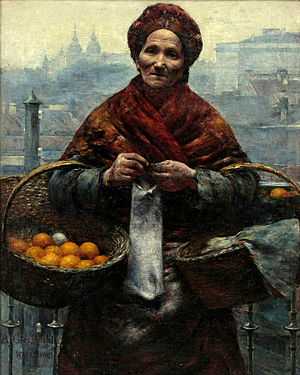World War II looting of Poland



The looting of Polish cultural artifacts during World War II was carried out by Nazi Germany and the Soviet Union side by side after the invasion of Poland of 1939. A significant portion of Poland's cultural heritage, estimated at about half a million art objects, was plundered by the occupying powers. Cataloged pieces are still occasionally recovered elsewhere and returned to Poland.
Priceless pieces of art still considered missing or found in Russian museums include works by Canaletto, Anna Bilińska-Bohdanowiczowa, Józef Brandt, Lucas Cranach the Elder, Lucas Cranach the Younger, Albrecht Dürer, Anthony van Dyck, Hans Holbein the Younger, Jacob Jordaens, Frans Luycx, Jacek Malczewski, Raphael, Rembrandt van Rijn, Peter Paul Rubens, Henryk Siemiradzki, Veit Stoss, Alfred Wierusz-Kowalski, Leon Wyczółkowski, Jan Matejko, Henri Gervex, Ludwig Buchhorn, Józef Simmler, Henri-Pierre Danloux, Jan Miense Molenaer and many others.[1]
As part of the efforts to locate and retrieve the missing pieces of art, the Ministry of Culture and National Heritage founded the Database of War Losses, as of 2013 containing over 63,000 entries.[2] The list is periodically sent to over 100 auction houses around the world, published by the Ministry and also submitted to the National Institute of Museology and Collections Protection, Polish embassies, and the Central Registry of Information on Looted Cultural Property 1933-1945 (lootedart.com).[2] In addition, the Ministry also founded the Lost Museum website, a virtual museum containing historic photographs of many pieces of art still missing.[2][3]
Background
At the beginning of the 1939 invasion of Poland, the Polish interwar government attempted to conceal the nation's most valued cultural heritage such as the royal treasures of the Wawel Castle in Kraków. The royal accessories including the Jagiellonian tapestries were secretly shipped to Western Europe and then to Canada among other places. At the end of the war, two parallel Polish governments, the Western-supported Polish government-in-exile and the Soviet-backed government in Communist Poland laid claims to these national treasures. The cultural artifacts were released by Canada to the People's Republic of Poland in February 1961.[4][5]
Nazi Germany
Following the German invasion of Poland in September 1939 and the occupation of Poland by German forces, the Nazi regime attempted to suppress Polish culture.[6] As part of that process, the Nazis confiscated Polish national heritage assets and much private property.[7][8] Acting on the legal decrees of October 19 and December 16 (Verordnung über die Beschlagnahme Kunstgegeständen im Generalgouvernement), several German agencies began the process of looting Polish museums and other collections, ostensibly considered necessary for the "securing" of German national interests.[9]
Thousands of art objects were plundered, as the Nazis carried out a plan put in place before the start of hostilities.[10] The looting was supervised by experts of the SS-Ahnenerbe, Einsatzgruppen units, who were responsible for art; and, by experts of Haupttreuhandstelle Ost, who were responsible for confiscating businesses and more mundane objects.[8] Nazi officials responsible for carrying-out the plan included Hans Posse, Josef Mühlmann and his half-brother Kajetan (a.k.a. Kai, both from the SS),[9][11][12] overseen by Dagobert Frey, an SS historian originally also from Austria, selected by Berlin to validate Poland as a "Teutonic land" without Jews.[13] In addition to the official looting by Nazi authorities, some looting was also carried out by individuals acting on their own initiative; in fact Mühlmann complained as early as on October 6, 1939, that many items he was tasked to secure had already been moved or simply stolen.[10][12] While the Nazis kept extensive documentation of newly acquired looted art pieces, the system was not foolproof, and they lost track of much of the looted goods during the increasingly haphazard evacuation of Polish territories in 1944.[12]
Most of the important art pieces had been "secured" by the Nazis within six months of September 1939; by the end of 1942, German officials estimated that "over 90%" of the art previously in Poland was in their possession.[8] Some art was shipped to German museums, such as the planned Führermuseum in Linz, while other art became the private property of Nazi officials.[8] In 1940, Hitler received a "gift" from Hans Frank, governor of occupied Poland - a collection, prepared by Mühlmanna, of 521 of the most valuable art pieces.[12] Frank aided by Oberführer Mühlmann, an art connoisseur, amassed a large collection of Polish art pieces.[12] The total cost of the Nazi theft and destruction of Polish art is estimated at 11.14 billion dollars (value in 2001 dollars).[14]
Over 516,000 individual art pieces were taken.[10] The exact number is uncertain as not all art was registered, and much of that documentation was lost as well.[10][12] Assessment of losses began during World War II under the auspices of the Polish government in exile and the Polish Underground State; in 1944, Karol Estreicher published in London the first work on this subject, Cultural Losses of Poland.[10] A 2010 estimate gave a figure of 75% for the percentage of cultural heritage lost by Poland during the war[3] (though that estimate covers both destroyed and lost cultural heritage).[9] The looted art included 11,000 paintings by Polish painters; 2,800 paintings by other European painters; 1,400 sculptures; 75,000 manuscripts; 25,000 maps, 22,000 books printed before 1800 (starodruki); 300,000 graphics, and hundreds of thousands of other items of artistic and historical value.[14] The number of looted or destroyed books is estimated at 1.5 million[14] to as high as 15[9] or 22 million.[10] Even exotic animals were taken from the zoos.[15]
During the genocidal campaign against the Polish Jews culminating in the Aktion Reinhard of 1942, extortion and mass looting became part of German economics, not only Nazi policy towards Poland's heritage.[16]
Robbery of Polish Jews and looting of their property became the norm. In every town and village, Jews were forced to hand over not merely gold, currency and other valuables, but virtually anything consumable, including furniture and clothing. Even items such as birdcages, door handles and hot-water bottles were looted. Any excuse, or none at all, became the pretext for extortion.[16]
Soviet Union
After the Soviet Union invaded Poland on September 17, 1939, it similarly engaged in the looting and destruction of the Polish cultural heritage.[9][18] It is estimated that soon after the invasion, about half of Polish museums and similar public institutions were dismantled in the territories occupied by the Soviets. Many items were shipped to Soviet museums such as the Moscow Museum of History and the Central Anti-Religious Museum (also in Moscow).[9] Other collections were simply done away with. For instance, during the liquidation of the Poland's Lwów Historical Museum in the early 1940, its holdings were transported to the basement of the Black (Czarna) Kamienica (pictured), away from public eye, and deliberately destroyed there.[17]
Following the reversal of wartime fortunes, and the Soviet advance across the German-occupied Polish lands, the looting and plunder of anything of value continued.[9] Looting by the Soviets was common up to 1947 even though the looted territories were theoretically assigned to its own ally, the communist Poland already.[9][19][20] The Soviet forces engaged in particularly extensive plunder in the former eastern territories of Germany that were to be transferred to Poland, stripping them of any piece of equipment left behind.[9][10][21][22] Even the Polish Communists felt uneasy about the scope of their crimes. In 1945, the future Chairman of the Polish Council of State, Gen. Aleksander Zawadzki, worried that "raping and looting of the Soviet army would provoke a civil war"[23] (see: rape during the liberation of Poland).
Efforts to locate and reclaim the lost art
After the war, the Polish Ministry of Culture and Art took over efforts to compile a list of lost art, locate it and recover it.[10] The Bureau of Revindication and Damages (Biuro Rewindykacji i Odszkodowań) operated from 1945 to 1951.[10] The realities of the Cold War made retrieval of looted cultural heritage difficult, and it was only in the 1980s and 1990s that the situation changed.[24] In 1991, a new body was formed for that purpose, the Bureau of the Government Representative for Polish Cultural Heritage Abroad (Biuro Pełnomocnika Rządu ds. Polskiego Dziedzictwa Kulturalnego Za Granicą), operating at the Ministry of Culture and Art.[10] In 1999, the initiative received support from the Polish Ministry of Foreign Affairs.[25] Once a looted piece of art is located, the Polish government issues a request for its restoration, and as noted on the Ministry website, all requests to date have been successful.[25] As of October 2012, the Ministry listed 30 objects which had been retrieved in the years 2001-2012.[26] Among the recovered art is the Aleksander Gierymski's Jewish woman found by surprise at the Eva Aldag auction house in Buxtehude in November 2010; returned to National Museum, Warsaw at the end of July 2011 and restored.[27]

On 1 August 2012, the Polish Ministry of Foreign Affairs announced that one of the most famous pieces of Polish art, Raphael's painting Portrait of a Young Man, had been found "in a bank vault in an undisclosed location"; a ministry spokesman was confident that the painting would eventually be returned to Poland.[28]
Currently, Poland is planning to build a virtual museum, the Lost Museum (Muzeum Utracone), which would feature the lost art.[3]
Both Germany and the countries of the former Soviet Union still have much Polish material looted during World War II.[29][30][31] In particular, recovering looted art from the former states of the Soviet Union, such as Russia, is proving difficult.[32][33]
Footnotes
- ↑ Agnieszka Sural (2013). "Najcenniejsze dzieła zaginione podczas II wojny światowej" [The most precious pieces of art missing since WWII]. culture.pl (in Polish) (Warsaw: Adam Mickiewicz Institute) (2013-08-13). Retrieved 2013-08-22.
- ↑ 2.0 2.1 2.2 Muzeum Utracone (corporate author) (2013). "About The Lost Museum". muzeumutracone.pl. Muzeum Utracone. Retrieved 2013-08-22.
- ↑ 3.0 3.1 3.2 "Zaginione polskie dzieła sztuki zobaczysz w internetowym muzeum - GP GazetaPrawna - Gazeta Prawna - partner pracodawcy, narzędzie specjalisty". Gazetaprawna.pl. Retrieved 2012-10-03.
- ↑ Aloysius Balawyder, "The odyssey of the Polish treasures", 1978, St. Francis Xavier University Press
- ↑ Gordon Swoger, The Strange Odyssey of Poland's National Treasures, 1939–1961, ISBN 1-55002-515-5, 2004, Dundurn
- ↑ Olsak-Glass, Judith (January 1999). "Review of Piotrowski's Poland's Holocaust". Sarmatian Review. Retrieved 2008-01-24.
- ↑ Rebecca Knuth (2003). Libricide: The Regime-Sponsored Destruction of Books and Libraries in the Twentieth Century. Greenwood Publishing Group. p. 86. ISBN 978-0-275-98088-7. Retrieved 2 October 2012.
- ↑ 8.0 8.1 8.2 8.3 Madajczyk 1970, p. 122.
- ↑ 9.0 9.1 9.2 9.3 9.4 9.5 9.6 9.7 9.8 "E28. Jasinski G". Polishresistance-ak.org. Retrieved 2012-10-03.
- ↑ 10.0 10.1 10.2 10.3 10.4 10.5 10.6 10.7 10.8 10.9 "Straty wojenne". Msz.gov.pl. Retrieved 2012-10-03.
- ↑ Ministerstwo Kultury i Sztuki, i Ministerstwo Odbudowy Kraju. "Warszawa Oskarża" (PDF direct download, 91.8 KB). Przewodnik po wystawie urządzonej przez Biuro Odbudowy Stolicy wespół z Muzeum Narodowym w Warszawie (in Polish). Drukarnia Narodowa, M-01526. Retrieved August 4, 2012.
- ↑ 12.0 12.1 12.2 12.3 12.4 12.5 Lokomobila. "Straty dziejowe". Zabytki.pl. Retrieved 2012-10-03.
- ↑ Department of Art, Art History, and Visual Studies of Duke University. "Frey, Dagobert". Dictionary of Art Historians. Retrieved August 4, 2012.
- ↑ 14.0 14.1 14.2 Dariusz Matelski (2005). Polityka Niemiec wobec polskich dóbr kultury w XX wieku. Wydawn. Adam Marszałek. p. 160. ISBN 978-83-7441-173-8. Retrieved 2 October 2012.
- ↑ Vernon N. Kisling (18 September 2000). Zoo and Aquarium History: Ancient Animal Collections To Zoological Gardens. CRC Press. p. 122. ISBN 978-0-8493-2100-9. Retrieved 2 October 2012.
- ↑ 16.0 16.1 ARC (2006). "Aktion Reinhard Economics". Google's cache. Aktion Reinhard. Retrieved 30 July 2014.
- ↑ 17.0 17.1 Jacek Miler (2000). "Zbiory lwowskie (VI). Muzeum Historyczne miasta Lwowa". Cenne. Bezcenne. Utracone. Archiwum (3/2000) (in Polish). Narodowy Instytut Muzealnictwa, Warszawa. Retrieved October 12, 2012.
- ↑ "Rewindykacje dóbr kultury z ZSRR po II wojnie światowej (część I)". Nimoz.pl. Retrieved 2012-10-03.
- ↑ Norman Davies, God's Playground, a History of Poland, Columbia University Press, 2005, ISBN 0231128193, p.359
- ↑ Richard C. Raack, Stalin's Drive to the West, 1938–1945: the origins of the Cold War, Stanford University Press, 1995, ISBN 0804724156, p.90
- ↑ "MIĘDZY MODERNIZACJĄ A MARNOTRAWSTWEM" (in Polish). Institute of National Remembrance. Archived from the original on 2005-03-21. See also other copy online
- ↑ "ARMIA CZERWONA NA DOLNYM ŚLĄSKU" (in Polish). Institute of National Remembrance. Archived from the original on 2005-03-21.
- ↑ Norman Davies, God's Playground, a History of Poland, Columbia University Press, 1982, ISBN 0231053525, p.558
- ↑ "Rewindykacja dóbr kultury". Msz.gov.pl. 2011-09-27. Retrieved 2012-10-03.
- ↑ 25.0 25.1 "Działalność MSZ w zakresie restytucji dóbr kultury". Msz.gov.pl. Retrieved 2012-10-03.
- ↑ "Odzyskane dzieła sztuki". Msz.gov.pl. Retrieved 2012-10-03.
- ↑ Konrad Niciński (March 2011). "Aleksander Gierymski "Żydówka z pomarańczami"". Culture.pl Adam Mickiewicz Institute. Retrieved 2012-10-22.
- ↑ "Raphael’s "Portrait of a Young Man" re-discovered". Panarmenian.Net. Retrieved 2012-08-01.
- ↑ (Polish) Rosjanie oddają skradzione dzieła sztuki, Gazeta Wyborcza, 2007-10-14
- ↑ Rp.pl (2011-09-26). "Rękopis Słowackiego odnaleziony w Rosji". rp.pl. Retrieved 2012-10-03.
- ↑ "Rosja gotowa jest zwrócić Polsce archiwalia przejęte w czasie II wojny światowej". Onet.pl. Retrieved 2012-10-03.
- ↑ "Rosjanie nie oddadzą skradzionych dzieł sztuki. Ale będą współpracować - WPROST". Wprost.pl. 2012-02-23. Retrieved 2012-10-03.
- ↑ Nazwa *. "Odzyskiwanie zabytków | Tygodnik "Przegląd"". Przeglad-tygodnik.pl. Retrieved 2012-10-03.
References
- Madajczyk, Czesław (1970), Polityka III Rzeszy w okupowanej Polsce, Tom II (Politics of the Third Reich in Occupied Poland, Part Two) (in Polish), Państwowe Wydawnictwo Naukowe
Further reading
- From The Smithsonian selected bibliography on the provenance of looted art:
- Estreicher, Karol. Cultural Losses of Poland: Index of Polish Cultural Losses during the German Occupation. London, 1944.
- Gołos, Jerzy and Agnieszka Kasprzak-Miler, eds. Straty wojenne: Zabytkowe dzwony utracone w latach 1939-1945 w granicach Polski po 1945 (Wartime Losses: Historic Bells Lost Between 1939-45 within post-1945 borders of Poland). Poznań, Ministerstwo Kultury i Sztuki, 2000.
- Kudelski, J. Robert. Tajemnice Nazistowskiej Grabieży Polskich Zbiorow Sztuki. Warsaw: Tower Graphics, 2004.
- Łaskarzewska, Hanna, ed. Pro memoria: warszawskie biblioteki naukowe w latach okupacji 1939-1945. Warsaw, Wydawnictwo Biblioteki Narodowej, 2004.
- Pro Memoria - Warszawskie biblioteki naukowe w latach okupacji - 1939-1945. Warsaw: Biblioteka Narodowa, 2004.
- Romanowska-Zadrożna, Maria and Tadeusz Zadrożny. Straty wojenne: Malarstwo obce: obrazy olejne, pastele, akwarele utracone w latach 1939-1945 w granicach Polski po 1945 bez ziem zachodnich i poółnocnych (Wartime Losses: Foreign Painting: Oil Paintings, Pastels, Watercolours, Lost Between 1939-1945 within post-1945 Borders of Poland Excluding the Western and Northern Territories). Poznań, Ministerstwo Kultury i Sztuki, 2000.
- Dariusz Matelski, Losy polskich dóbr kultury w Rosji i ZSRR, Poznań 2003.
- Dariusz Matelski, Polityka Niemiec wobec polskich dóbr kultury w XX wieku, Toruń 2005 (wyd. II, Toruń 2007).
External links
| Wikimedia Commons has media related to Art lost in Poland during World War II. |
